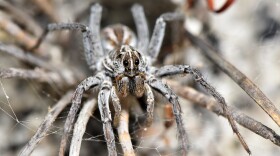-
Phidippus apacheanus is a species of jumping spider in the family Salticidae. It is found in the United States, Mexico, and Cuba.
-
Wolf spiders are members of the family Lycosidae. They are robust and agile hunters with excellent eyesight. They live mostly in solitude, hunt alone, and do not spin webs. Some are opportunistic hunters, pouncing upon prey as they find it or chasing it over short distances; others wait for passing prey in or near the mouth of a burrow.
-
Wolf spiders are members of the family Lycosidae. They are robust and agile hunters with excellent eyesight. They live mostly in solitude, hunt alone, and do not spin webs. Some are opportunistic hunters, pouncing upon prey as they find it or chasing it over short distances; others wait for passing prey in or near the mouth of a burrow.
-
Nephila is a genus of araneomorph spiders noted for the impressive webs they weave. Nephila consists of numerous species found in warmer regions around the world. They are commonly called golden silk orb-weavers, golden orb-weavers, giant wood spiders, or banana spiders.
-
Nephila is a genus of araneomorph spiders noted for the impressive webs they weave. Nephila consists of numerous species found in warmer regions around the world. They are commonly called golden silk orb-weavers, golden orb-weavers, giant wood spiders, or banana spiders.
-
Lyssomanes viridis, commonly known as the magnolia green jumper, is a species of jumping spider of the genus Lyssomanes, for which it is the type species. The species is native to the United States, being found in much of the Southeastern United States and Texas. It has also been reported from parts of Mexico, with sightings as far south as Guatemala and as far north as Maryland.
-
Lyssomanes viridis, commonly known as the magnolia green jumper, is a species of jumping spider of the genus Lyssomanes, for which it is the type species. The species is native to the United States, being found in much of the Southeastern United States and Texas. It has also been reported from parts of Mexico, with sightings as far south as Guatemala and as far north as Maryland.
-
Miner bees (Anthophora abrupta), also known as chimney bees, are smaller than a honey bee, with a stout, furry body. They are often mistaken for bumble bees, also being black and yellow summertime bees. They are friendly, non-aggressive and typically do not sting or bite. Despite their small stature, mining bees are very important to flower pollination, especially in the mid-west region of the United States. Anthophora abrupta’s geographic distribution ranges from Texas to Florida, stretching up the East Coast to Canada.
-
Miner bees (Anthophora abrupta), also known as chimney bees, are smaller than a honey bee, with a stout, furry body. They are often mistaken for bumble bees, also being black and yellow summertime bees. They are friendly, non-aggressive and typically do not sting or bite. Despite their small stature, mining bees are very important to flower pollination, especially in the mid-west region of the United States. Anthophora abrupta’s geographic distribution ranges from Texas to Florida, stretching up the East Coast to Canada.
-
The Agelenidae are a large family of spiders in the suborder Araneomorphae. The most widely accepted common name for members of the family is funnel weaver.

Play Live Radio
Next Up:
0:00
0:00
Available On Air Stations






